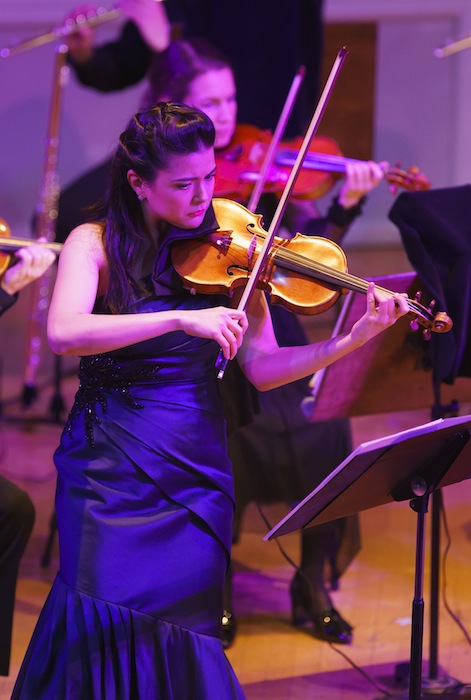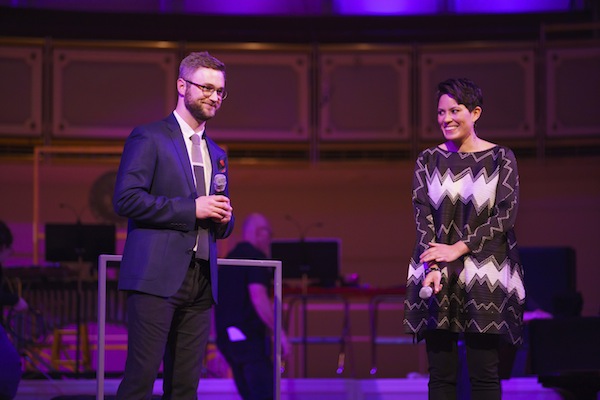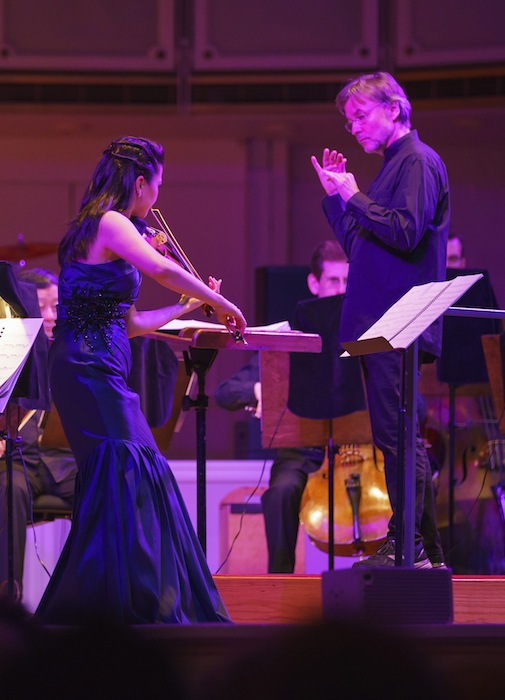MusicNOW closes 20th anniversary season on a high note with Salonen leading Adams, Ogonek premieres

There was more buzz than usual Monday night at the final MusicNOW concert of this 20th anniversary season.
Part of it was due to the Chicago Symphony Orchestra’s new-music series returning to where it began, humbly, two decades ago at its Symphony Center home base; with seating limited to the main floor, there was a degree of enforced social intimacy that contrasted pleasurably with the cavernous Harris Theater.
And partly it was due to the program being conducted by Esa-Pekka Salonen. Currently at the midpoint of his two-week CSO residency, Salonen has earned acclaim for this past week’s probing performances of Mahler’s Ninth Symphony.
But most importantly, the evening marked the farewell appearances of the CSO’s out-going composers in residence, Samuel Adams and Elizabeth Ogonek, with a world premiere from each commissioned by MusicNOW for the occasion.
I haven’t been knocked sideways by the music Sam Adams has produced during his Chicago tenure. But his violin concerto–perversely titled Chamber Concerto–is, with reservations, his best work to date and ends his CSO tenure on the positive side of the ledger.
In the program note, Adams speaks of his aversion to the show-offy brilliance of the traditional Romantic concerto with its heroic soloist set against the orchestra. Instead, he here takes his inspiration from Baroque models of Bach, Vivaldi, and Corelli, with his own contemporary twist.
In his characteristic, highfalutin explication, Adams says he is intrigued by the idea that “multiple levels of musical consciousness can be realized through sound” and envisions “an ensemble as a kind of collective unconscious, their interplay engendering a psychological narrative.” For that, he “felt it was necessary to use well-known formal ‘cognates’ to create the landscape through which the violin moves.” Well, okay.
Adams’ tortuously intellectual inspiration often results in music that is dry and awkwardly worked out. There are issues with his Chamber Concerto, as well. But the brilliant, dazzling playing of violinist Karen Gomyo bodily lifted this premiere above its occasional technical weaknesses.
The Chamber Concerto is cast in five movements spanning a half-hour. The concerto opens (“Prelude: One by One”) with a lovely lyrical theme for the soloist, which then passes to other instruments in the large chamber orchestra. The rhythms grow quicker and the music turns more aggressive, leading directly into the second section “Lines (after J).” Beginning with marimba and prepared piano, the music accelerates into blindingly demanding solo passages, thrown off by Gomyo with sizzling bravura. The edgy, dark music is quelled and the violin line ascends in ever-higher lines, segueing into richly lyrical solo passages and a plaintive, introspective cadenza.
After a pause, the three final sections are played attacca. In “Slow Movements” there are numbed, “frozen” statements from the solo violin, answered by rustling responses from the orchestra, meant to echo the Baroque ritornello. “On/Off” is a jumpy, mercurial, off-beat dance with more solo fireworks and comical moments for bass clarinet.
The final section (“Postlude: All Together Now”) begins with the solo violin suspended on a high C-sharp, descending in broken phrases. Here is where Adams’ Chamber Concerto loses the thread; the violin’s high melodies and statements separated by rests “loses steam” as Adams intends, but so does the score, in music that is meandering, overlong and repetitious. There is a sense of coming full circle at the coda with the violinist reprising the lyrical solo statement, this time joined by the ensemble.
Orchestration continues to be Adams’ Achilles heel. Despite the coloristic potential of his large chamber forces (flute/piccolo, flute/alto flute, clarinet, bass clarinet/contrabass clarinet, string sextet, two percussionists, piano/Fender Rhodes), his scoring doesn’t utilize his resources effectively; too often unvaried and heavy, the ensemble often feels like a drag on the soloist rather than an equal partner.
Even with qualifiers, the Chamber Concerto is still the most successful work of Adams’ CSO residency. Still, this score could be improved by some judicious trimming, and one feels that there is an inspired 24-minute concerto lying within this half-hour work.
Ironically, despite the composer’s stated dislike of heroic Romantic concertos, it is precisely when Adams’ Chamber Concerto is closest to such traditional elements that it is most effective. Gomyo’s remarkable solo turn offered both warm lyrical engagement as well as staggering bravura that spoke much more eloquently that Adams’ “cognates” and theoretical underpinnings. Salonen drew equally bold and richly committed playing from the chamber orchestra.
Elizabeth Ogonek’s The Water Cantos [notes from quiet places] was the evening’s other world premiere. The four movements of this work for mixed chamber ensemble depict musical portraits of various natural phenomena of the American West–specifically locales in northern New Mexico and southern Oregon–that have provided a refuge to the composer as places to “recharge and re-engage.”

Overlong movement titles apart, Ogonek’s music is effective and surely crafted in its lightly distilled depictions. The opening section–“Processional: Winter Road (Aspen Vista)”–opens with an air of nature mystery that moves to peaceful music with some pensive accents, and a richly lyrical theme for cellos. The watery inspiration is unmistakeable in “Montage: Falling Blue (Elk River)” with its easygoing charm and seesawing winds. Darker undercurrents surface, as well as a passing aquatic crib from Britten’s “Sea Interludes” from Peter Grimes.
“Song: On Becoming a Wave (Face Rock),” offers another mellow cello theme, and the brief finale “Scherzo: One Last Drop (Ghost Ranch)” is a cantering episode like a Scottish reel, antic and lively before stopping abruptly.
There is a prevailing lightness of being in Ogonek’s Water Cantos but not everything has to be Erwartung. Though it doesn’t have the expressive depth of In Silence—the finest work of Ogonek’s CSO tenure, her new work is surely crafted, scored with skill and facility and conveying its sense of al fresco relaxed contentment. Salonen directed the premiere with alert dedication, and Ogonek’s premiere earned strong applause.
Unlike The Water Cantos, Anna Thorvalsdottir’s Ró (stillness) is not a direct depiction of natural phenomena. But it’s not hard to sense something of the forbidding, treeless landscape of the composer’s native Iceland in this music. Artfully scored for mixed octet (bass flute, bass clarinet, piano, percussion and string quartet), the score barely rises above a whisper, centering on hushed sustaining pitches and rarefied concentration with striking effects (like crunching paper) that add to the eerie yet strangely inviting atmosphere. Salonen led a concentrated performance that conveyed Thorvaldsdottir’s becalmed yet haunting sonic landscape.
The concert began with Magnus Lindberg’s Related Rocks. Scored for pairs of pianists and percussionists with electronics, this is a transitional work (1997) between the Finnish composer’s ascetic early style and his current, more openly tonal music.
Despite its complexities and a tortuous compositional process, Related Rocks unfolds in a fluent, organic fashion over its 18-minute span, with the electronics adding an offbeat sonic overlay to the live playing. Commencing with high percussion and piano notes, the music moves from a shimmering austerity, through tempo accelerations, fast marimba riffs, strange harmonic sections, and an antique harmonium-like passage for two synthesizers, culminating in a playful Finnish boogie-woogie.
Percussionists Vadim Karpinos and Ian Ding and pianists Daniel Schlosberg and Mio Nakamura served up an atmospheric and alertly coordinated performance with Ding deftly keeping the score on track, conducting as needed.
Esa-Pekka Salonen is the un-maestro, directing Monday night’s demanding program sans baton with unruffled ease and a graceful blend of precision and flexibility. In a preconcert conversation with the composers and Gomyo, the Finnish conductor was relaxed, engaging and very funny. Ending each MusicNOW season with a Salonen-led program would not be the worst idea in the world.
Posted in Performances





